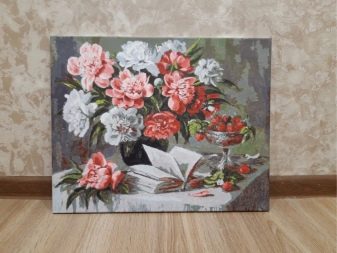Paintings by numbers on canvas
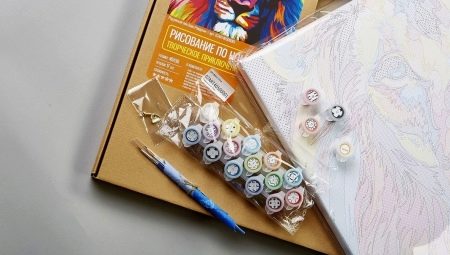
It is no secret that many of us from time to time dream of trying on the image of an artist: to paint a beautiful picture, to reveal creative abilities and just to get away from the hustle and bustle. Using kits for drawing by numbers, this task becomes within the power of anyone, even a novice painter.
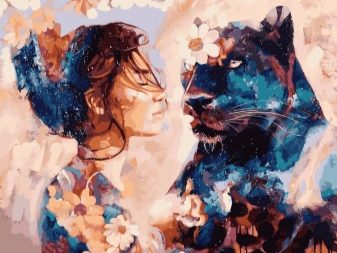
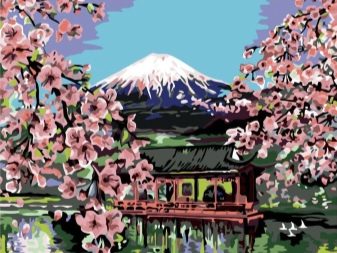
It is included in the kit?
The creation of paintings by numbers involves the use of kits for painting the areas indicated by the contours with paints on a previously prepared basis (usually canvas, less often plywood and cardboard). All areas of the painting are numbered, each corresponding to a particular shade. Typically, aqueous acrylic dyes are used. The brightness and durability of their shades determine the aesthetic appearance of the finished works.
As for the color scheme, only base tones paints may be present in the kit - to achieve the desired effect, they must be mixed. But more often this is an exception, since most of the manufacturers offer ready-to-use sets of paints of suitable shades in the required volume.
The palette is harmoniously matched to the storyline of the painting, and the artist is only required to choose the right colors in accordance with the numbering on the basis.
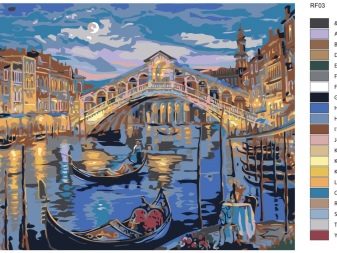
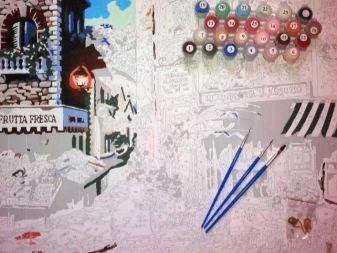
Let's find out what else is included in the kit.
- Canvas - made of cotton cloth or cardboard. Professionals usually prefer the first option, as it allows you to feel like a real painter. However, cardboard also has its merits: it has a democratic cost, besides, it quickly absorbs excess paint. In any case, the canvas is divided into several numbered sections.For people with vision problems and young children, manufacturers offer a slightly transparent canvas.
- Scheme - used in unforeseen cases. For example, when a block number is accidentally dirty with something. In such a situation, the sheet will be needed for orientation.
- Painting picture in color - demonstrates how the drawing should turn out in the end.
- Paints - each jar is assigned a specific number, which exactly corresponds to a particular section on the canvas. This allows even an inexperienced artist to find the right shade. Usually acrylic dyes of saturated shades are poured into the jars, which do not fade in the light and do not smudge during work. There are also kits with watercolors, but working with them is much more difficult, since you have to take care of the layering to cover the numbers.
- Brushes - the set includes several pieces of different thickness. Made of polymer materials.
- Varnish - used to fix the result, protects the painting from dust, fading and cracking.
- Hangers - if you fasten them to a stretcher and hang them on a nail by a string, then there will be no need to buy a frame.
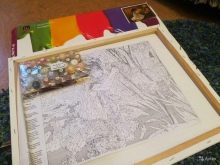
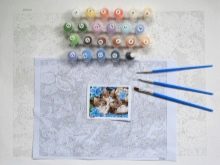
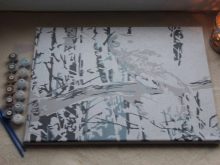
Views
All variants of sets of paintings by numbers are classified according to the plot, as well as age categories. They have not only different dimensions, but also different levels of coloring complexity, that is, image detail. For example, individual parts can be very small or the whole drawing from large parts for filling with different paints.
There are several types of kits.
- Classic coloring - typical sets, consisting of a canvas with sections lined on it, multi-colored dyes and several brushes of different thicknesses.

- Luminescent paintings - belong to special types. In addition to the basic composition, the set also includes luminescent paints, which are applied to an already finished image. This technique gives the painting the effect of a glow in the dark.

- Paintings-watches - include a working clock mechanism, which is assembled into a picture.
The result is a very beautiful and, moreover, a necessary thing in everyday life.
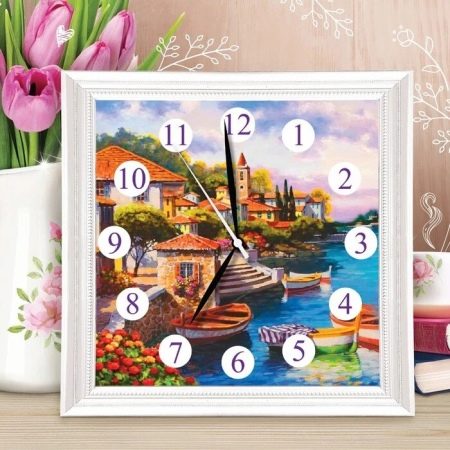
- Mandala painting - provides a standard scheme with numbering, dividing the picture into several color zones. It may not have numbers, leaving the novice artist the opportunity to choose colors on their own, guided only by their imagination.

The most popular subjects include still lifes, images of animals; themes with cats, dogs and horses are in particular demand. Many sets offer schemes for creating flowers: roses, poppies, daisies, sunflowers, lilacs, orchids. Still lifes are no less in demand. Pictures with the city landscapes of London and the streets of Italy turn out to be very cool, girls like to paint pictures with a ballerina, boys - sailboats, adults sometimes like abstraction. Among experienced craftsmen, reproductions of paintings by famous artists are in demand.
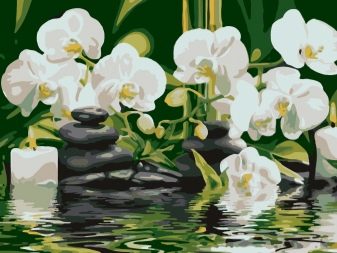
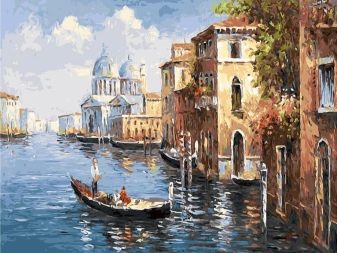
How to choose?
Modern manufacturers produce paintings by numbers of several standard sizes:
- 10x15 cm;
- 20x30 cm;
- 30x30 cm;
- 30x40 cm;
- 40x40 cm;
- 40x50 cm;
- 50x65 cm;
- 40x80 cm;
- 60x80 cm;
- 100x150 cm.
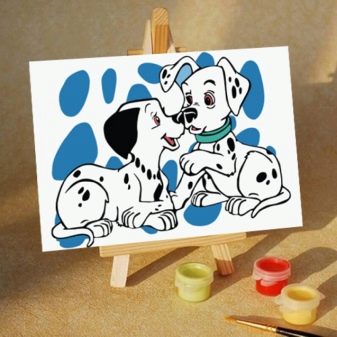
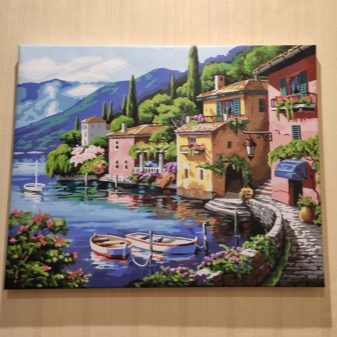
Of course, there are coloring pages of large dimensions, but, as a rule, they are offered in a composite form (for example, triptychs). Or you can buy them disassembled (separately the slats, which you need to assemble in the future, and separately the canvas, which, upon completion of the work, will have to be pulled onto the frame assembled from the slats).
Small coloring pages with large segments and very little detailing are suitable for children, and large paintings by numbers with many small details in different colors and a significant amount of colors are optimal for adults. Of course, the larger the canvas and the more small details on it for coloring with the thinnest brushes, the more difficult the work will be and the longer it will take to work on it, but the result will delight and delight the eye.

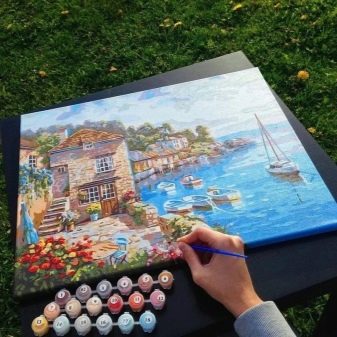
When choosing a painting by numbers, you should pay attention to the degree of complexity.
It directly depends on the size of the elements, the outlines of which are applied to the canvas, and the amount of dyes in the set. Different manufacturers have different gradations. But in general, the complexity parameters can be roughly divided as follows:
- initial - the drawing consists of large color spots;
- medium - there are large, medium blocks in the picture, as well as a small number of small ones;
- complex - the image contains many small and very small elements.


Manufacturers rating
The most popular are sets of paintings by numbers from the following manufacturers.
- ArtStory - specializes in color mandala paintings of a low level of complexity. Russian-made kits are sold in a tight box, canvas is made of linen, varnish is provided for the topcoat. The assortment of this manufacturer also includes paintings by numbers on wooden panels and a children's ruler measuring 20x25 cm.
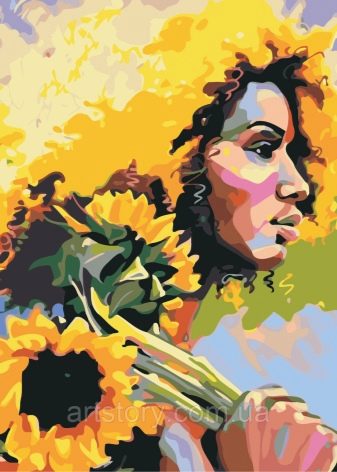

- Babylon - a manufacturer of quality sets from China. Produces sets on linen canvas, the colors are thicker in comparison with competitors. Pictures are distinguished by increased detail. This brand also has the Babylon Premium series. It is more expensive, includes varnish to cover the design, a palette for mixing shades and a couple of fixtures.


- Brushme - a brand of paintings by numbers from Chernivtsi, famous for its unique plots. Drawings are created on cotton canvas. There is a premium Brush Premium series on linen canvas with a nude outline.


- "Ideyka" - Ukrainian manufacturer. He puts a sample in his kits, as well as instructions for coloring. Cotton canvas, dye jars close the most tightly. The assortment list includes sets of a wide variety of sizes (from 25x25 to 40x50 cm), as well as polyptyches of 4 images.
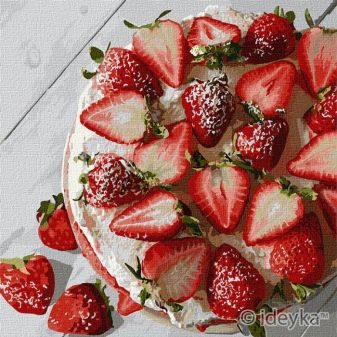
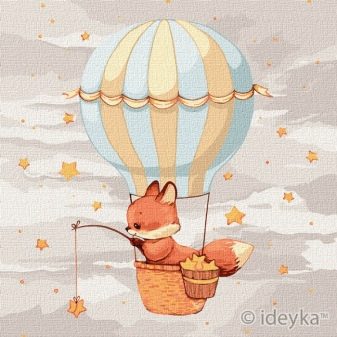
- Rainbow art - this manufacturer constantly changes its storyline, delighting aspiring creators with modern images. Produces both standard sets based on cotton, and rulers on wood. The kit "drawing by numbers + diamond embroidery" is especially popular.
The paintings are offered in a typical size of 40x50 cm.


How to draw correctly?
At first glance, it may seem that the creation of paintings by numbers is subject to a single algorithm. However, this is not at all the case - there are several ways to create drawings.
- Coloring from light to dark - this is convenient when blots appear, especially taking into account the fact that acrylic dyes are almost impossible to erase with water. Therefore, the place of the blot must be closed. And, obviously, yellow, pink, beige, as well as blue and any other light tones are much easier to overlap with dark ones.
- Coloring from large to small areas - it will also help to minimize blotting. In addition, working on small elements will be much easier. Glare and shading are easier to apply when the overall picture is almost complete.
- Coloring from the center towards the edges - taking into account that sometimes the “core” of an artistic composition is in the center, this technique is very convenient. Having worked first of all on drawing the middle, all other blocks will be painted faster. This technique is especially popular among craftsmen, who sometimes smear everything drawn earlier with their sleeve.
- Coloring in order of colors - optimal for those who are worried about drying out paints in cans. Consuming one pack while the others are closed reduces this risk to zero.
- Experiment with contours - helps to achieve unusual results and bring something original to the picture. If some borders are highlighted, and others, on the contrary, are slightly smeared, then a rather expressive and stylish canvas can be obtained.
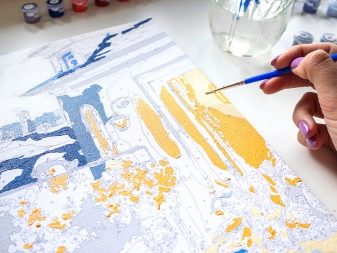
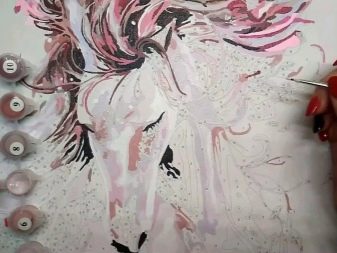
Experienced artisans share their painting-making secrets that make the painting process more accurate.
- The workplace should be well lit. Of course, daylight is best, although an artificial source is also needed. The luminaire should be bright, but not dazzling.
- Before starting painting, it is important to prepare the dyes. Acrylics are usually not thinned, although a few drops of water will help to advantageously adjust the viscosity. It is advisable to mix paints with a toothpick or a match.
- If an error occurs during the creation of the picture, there is no need to try to eliminate the unsuccessful blooper with water. Acrylic dye dries quite quickly - and in this form it is no longer washed off. If you get into trouble, you need to cover the damaged area with the main tone paint.
- After any color change, as well as at the end of the work, the brushes must be washed. The paint cans should be closed tightly, having previously cleaned them of the dye residues. If this is not done, the latter will dry out.
- If it's permissible within the style of the drawing, you can experiment with shading or drawing with small dots. Let's say that small ripples from dots will allow you to convey the texture of a rain cloud, and a fan of rainy threads will imitate oblique short strokes. If you intend to give the finished drawing more expressiveness, it makes sense to resort to creating blurry and sharp boundaries.
You can find areas where you need to slightly smear the edges or make clear outlines by examining these segments on the reproduction sample.

How to register?
Acrylic dyes give a rich color that retains brightness for a long time. But surely many people want to prolong these qualities as long as possible. For this, varnish is often used.
The varnish is matte and glossy. The first dries up quickly. The second provides shine and visually levels the surface. When creating the effect of antiquity, you should make a choice in favor of sets with craquelure varnish. It allows you to create stylish cracks for antiques.
Finished paintings need to be straightened, smoothed and varnished. You can't do without a stylish frame for the finished image. In terms of its visual qualities, acrylic is practically not inferior to classic oil. Such works can be pulled on a textured, slightly recessed frame with exquisite gilding or silvering in baroque design.
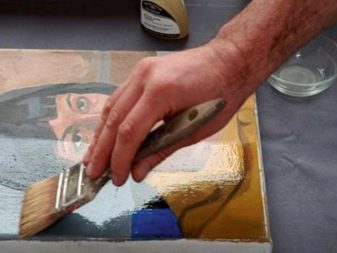
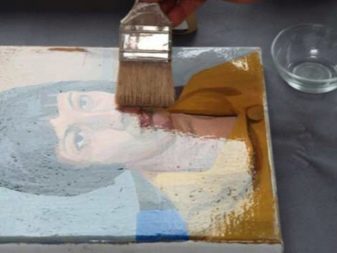
The decor with grape vines, refined ligature and vignette is invariably in trend. In this design, the drawing will acquire a greater volume.
A stylish solution is not to stretch the canvas, but to paint the ends in a matte, discreet color scheme. Keep in mind that interior paintings painted on canvas can not be framed. An image on cardboard without proper framing will look unfinished.

